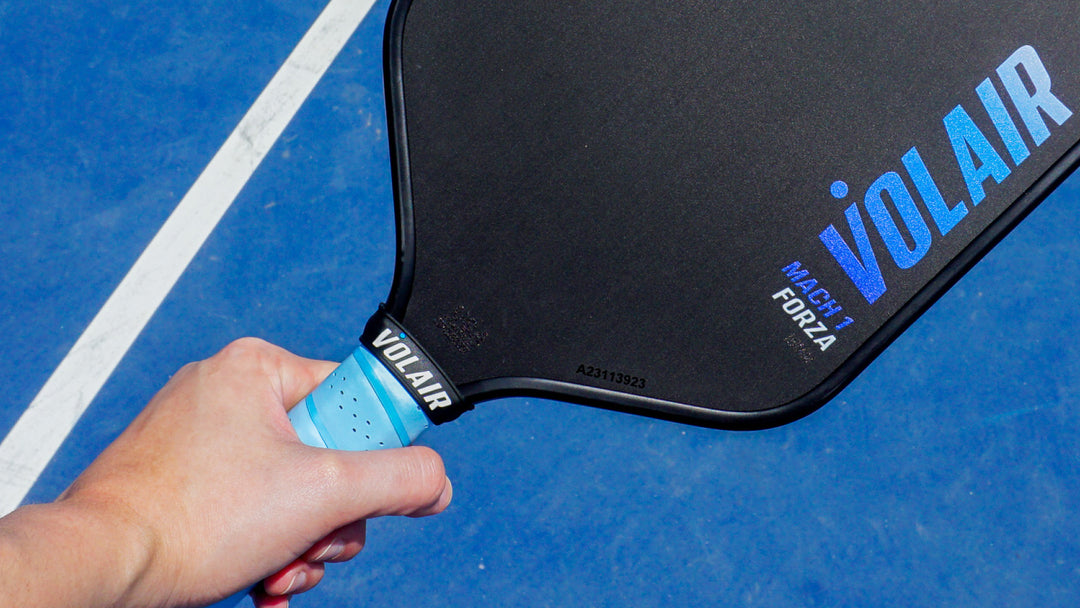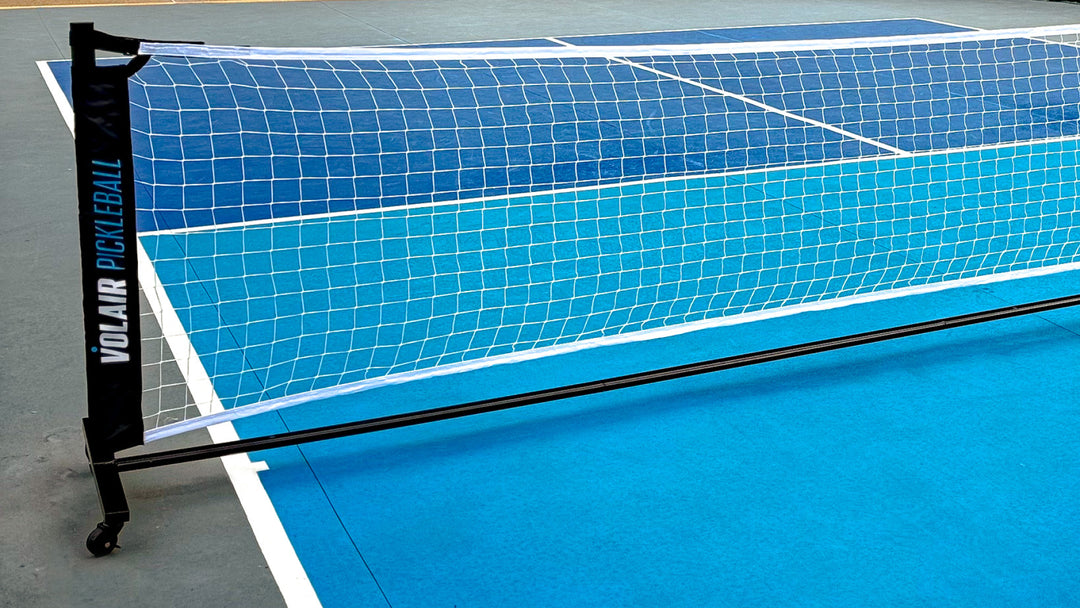From Whack to Whammy: The Evolution of Pickleball Paddles
Forget the "whammy" sounds for now – the crack of the paddle against the pickleball speaks volumes about your game. But the paddle itself? It's undergone a revolution. Buckle up as we dive into the history and development of this essential pickleball weapon. We'll explore the materials, technologies, and features that have transformed the humble paddle from a basic tool into a high-tech extension of your skill. Get ready to see your game soar!
The Wooden Wonder Years (1960s-1970s):
Before there was a pickleball court, there was a backyard on Bainbridge Island, Washington. In the mid 1960s, Joel Pritchard and Barney McCallum were searching for an activity to en

tertain their families while visiting Bainbridge. They improvised a new sport by beating around a Perforated plastic ball on a lowered badminton net with (you guessed it) ping-pong paddles.
Pritchard and McCallum settled on a modified version of badminton for their lawn game, but those improvised paddles were lightweight novelties found at any hardware store. The paddles had no business being used for that purpose; they were too light, too impotent to drive the ball toward the target. The Bainbridge Badminton Pioneers tried their pretend sport imperfectly armed.
Enter the Polymer Powerhouse (1980s-2000s):
As pickleball spread and the competition got fiercer, players sought better paddles to keep up with the pace. In the 1980s, polymer core paddles entered the scene. The idea was simple: take a lightweight yet strong material like polypropylene or aluminum honeycomb, and replace the wood inside the paddle. A big leap forward. The paddles got lighter, stronger, and the players could hit the ball harder. Hard-hitting low volleys and baseline rallies became more common.
The Sweet Spot Revolution (1990s):
However, the real fun kicked off in the 1990s, when graphite composite faces arrived, transforming the sport to reach a larger audience. Graphite provided an enormous, more responsive ‘sweet spot’, the spot on the paddle that gives you the most feel and power on contact with the ball. Now, players of all abilities could have the ability to, as the saying goes, crush the ball and be thrilled by the sport of pickleball. At the same time, increased stiffness in the graphite material meant more stroke potential. With stiffer material came the ability to muster more horsepower into such shots as a dink or volley, creating a new aspect of competitive pickleball at the net.

The Age of Innovation (2000s-Present)
In the new millennium, tech took off! Paddle makers exploited these innovations, incorporating a variety of new materials and production methods to make even better pickleball paddles. Further details regarding several key innovations include:
T700 Carbon Fiber
The unique balance of flex and rigidity made for a more responsive connection, enabling players to produce more power than ever with a paddle made of older graphite materials. Making this transformation was a strategically deliberate decision, which involved fine-tuning the carbon fibers and resin matrix for a lighter but not ‘flimsy’ product that offered, as Carl puts it, ‘a great touch to the ball’ while being less tiring to play when involved in long rallies for half an hour on end.
Kevlar®
This aramid fiber provides some flexibility to the T700 series carbon fiber structure. Of course, halting some vibration allows you to exercise more precise control over the shot at impact for a greater degree of accuracy. With a Kevlar®, you gain the power and strength of the T700-series, but with the enhancement of comfort and confidence.
Unibody Construction
Where older paddles were two-piece items with a separate core glued to a separate face, unibody paddles were built with a single piece. This meant they were stronger, they had more consistency from one end to the other and across the striking surface, and they had a much cleaner, less busy look. It also meant players could be confident that their equipment was up to taking the punishment of competition.
Textured-surface paddles
The introduction of textured surfaces on the paddle face revolutionized the game. This innovation allowed players to impart greater spin on the ball, leading to more control over shots and the ability to create deceptive plays. A textured surface could be achieved through various methods, like etching tiny patterns onto the smooth graphite face or incorporating a layer of roughened material into the paddle construction. The type and coarseness of the texture would also vary depending on the desired level of spin and feel. This allowed players to explore new techniques and outmaneuver their opponents, adding a strategic dimension to the game.
Weight and Balance
Manufacturers started paying attention to weight distribution. Paddles are available over a much larger range of weights and balance points, and players can select a paddle that fits their playing style and preferences. A player who wants more powerful volleys might select a slightly heavier paddle with a head-heavy balance, while a player seeking maximum maneuverability might select the lightest paddle they can find, at an even balance – a light head reacts more easily and faster to one’s actions.
Finding Your Perfect Paddle
With all these innovations, there is a pickleball paddle for every type of player, from aggressive players in their 20s, to savvy, strategic players in their 50s. During the selection of your pickleball paddle, consider the following.
Your Playing Style
Are you a smasher or a player of controlled and consistent shots? Think about the type of shots you like to hit the most and choose your paddle accordingly.
Paddle Weight
Speed or power? Do you want a lighter paddle for fast swings or a heavier one for more force? A lightweight paddle could be useful for players who prefer quick movement and fast reactions, but keep in mind that a heavier paddle will add some punch for bigger swings if you dethrone your opponent on the baseline.
Balance
Do you want power, so be head-heavy? Or balance, for maximum stability? Try different paddles, then see what feels better, and how you can make your intended shots more accurate.
Paddle Grip Size
Make sure the grip feels comfortable in your hand. A secure and comfortable grip is essential for good control and reduces the risk of injuries.
The Future of Pickleball Paddles
With pickleball set to skyrocket in popularity for the foreseeable future, the evolution of the pickleball paddle is far from over. Here’s what might come next:
Smart Paddle
The paddle has an embedded sensor that tracks your swing speed, and shot placement, and offers coaching recommendations. With improved sensor technology, a smart paddle could be a reality. It could provide feedback to players of all levels, allowing them to improve their game as well as track their progress in real-time.
Adaptive Materials
Paddles that adapt to your game? Only in science fiction? Materials science moves forward fast and, in the future, it might be possible to make a paddle that allows players to feel how the head stiffens for power shots and absorbs vibrations for volleys.
Sustainable Materials
Given today’s rising environmental consciousness, you’ll probably soon start seeing more recycled, bio-based, or otherwise cradle-to-cradle pickleball paddles. Climate-change-fighting advantages notwithstanding, your pickleball paddle can remain competitive without hurting anyone’s chances of getting to the finals.
Embrace the Journey
That pickleball paddle has evolved over the years, and, like the sport itself, the game has continued to move forward: embracing technology and the innovations that have given itself a legitimate chance to survive. Paddles may see more playing time; nonetheless, the good feelings remain. Grab a paddle and step on the court. Pickleball is magic.




